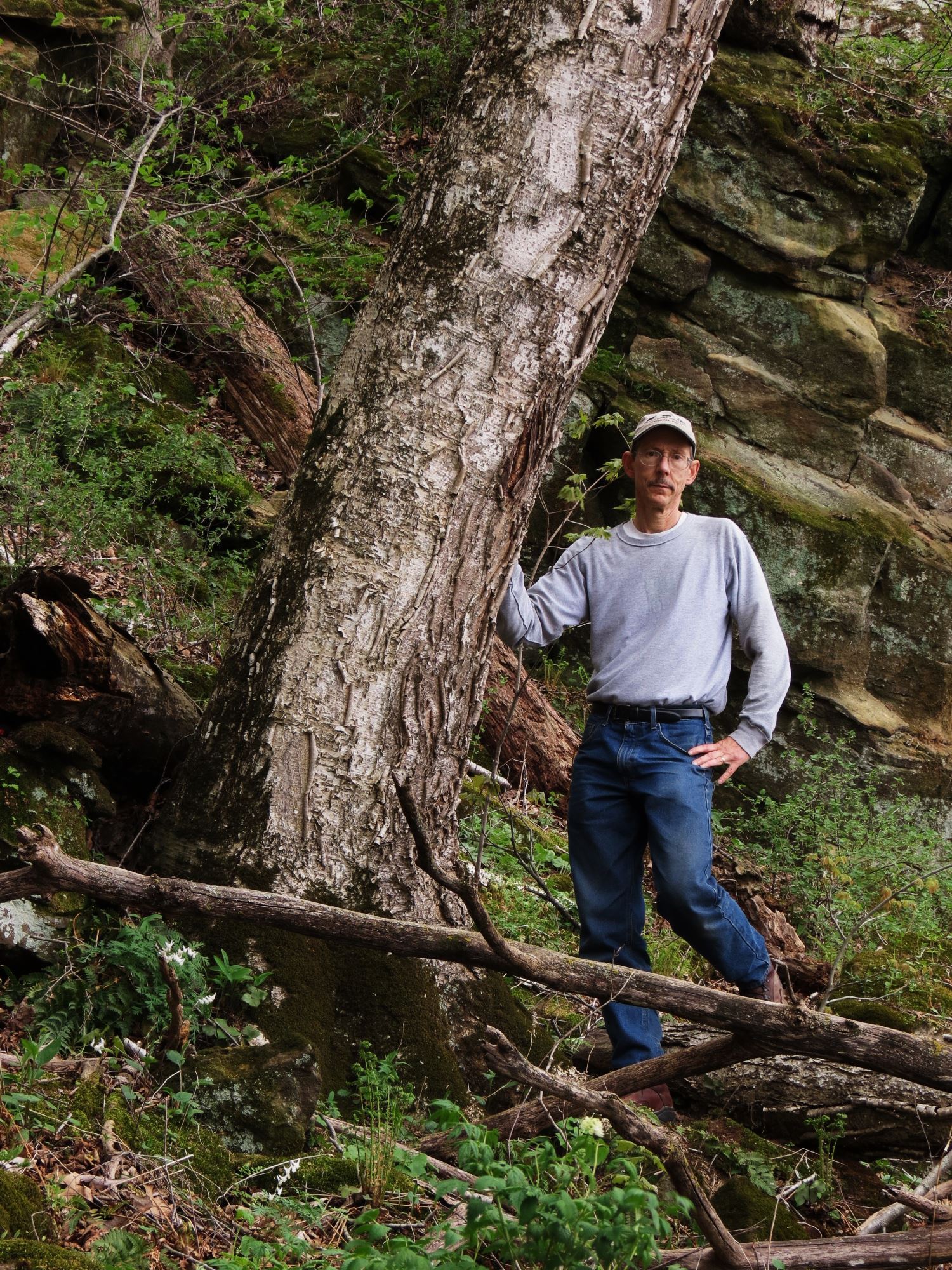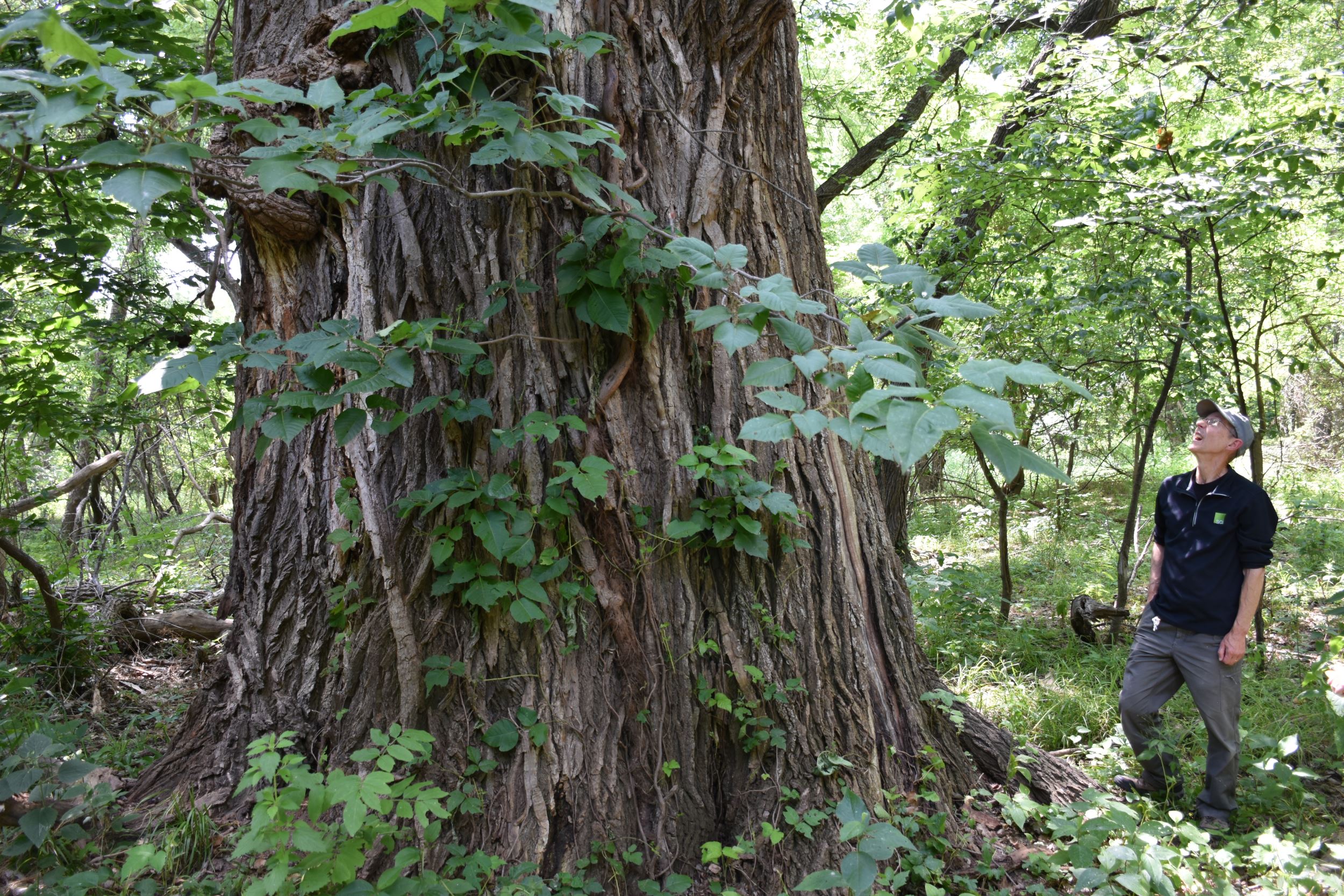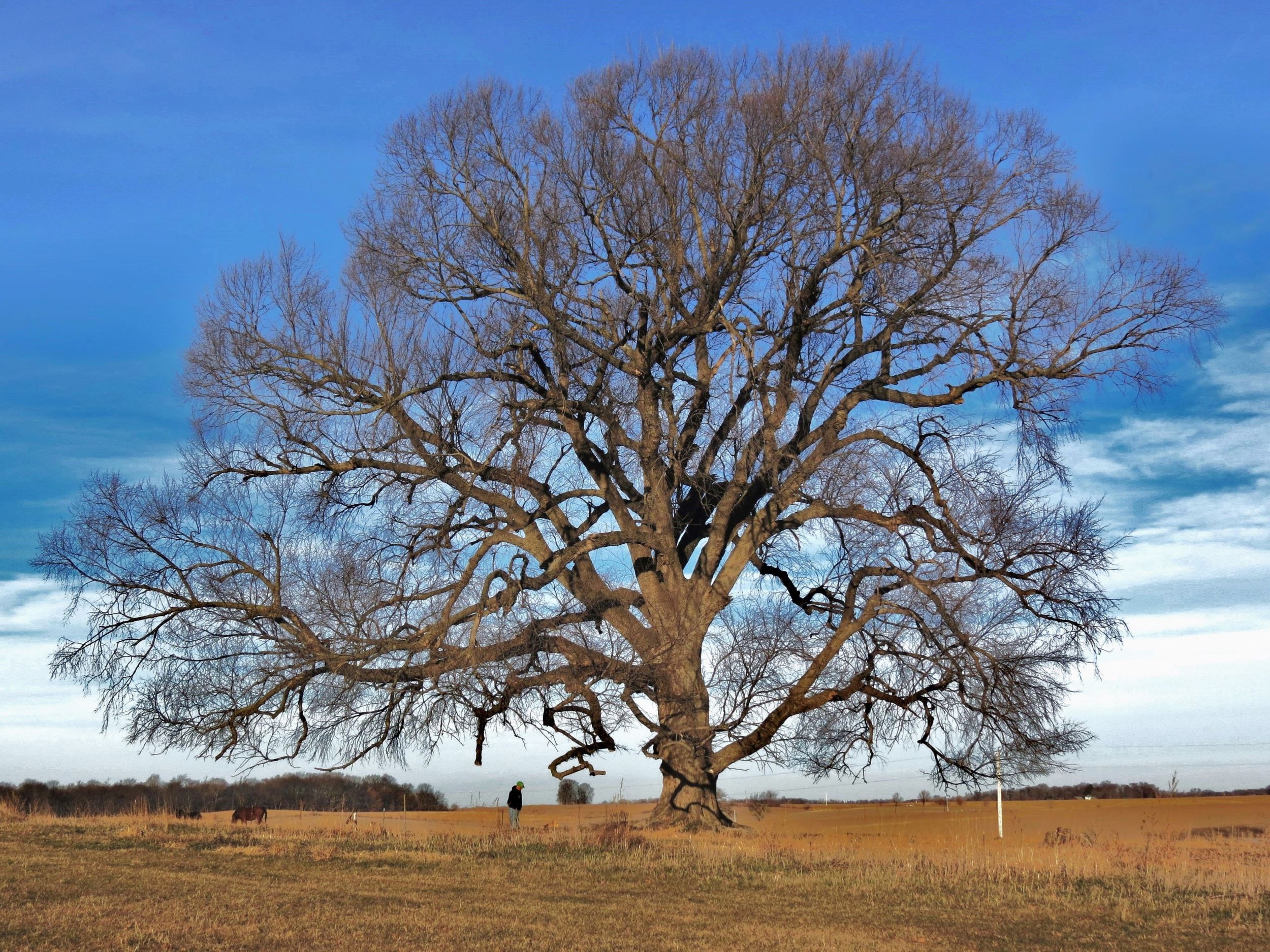Chasing Champions
By Erica Place on October 5, 2023 in Blog
Although the exact number is tricky to surmise from early surveyor notes or plat maps, it’s estimated that somewhere between 12 and 20 percent of Iowa was forested in some way at the time of statehood in 1846. At the very least, the land area occupied by woodlands has since been cut in half — a remaining estimated 5.7%. The majority of this is found on privately-owned land, with only about 8% of Iowa’s current woodlands being in state forests or county or state parks.
There are likely few people as intimately familiar with Iowa’s woodlands as Mark Rouw. Rouw has been scouring parks, neighborhoods, cemeteries and campuses for big trees since the 1970s.
Becoming a big tree expert
Rouw grew up in a Des Moines neighborhood with a backyard tree he credits to planting his passion’s seed. A large elm, bark worn smooth from repeated climbs, provided refuge and an opportunity to learn.
“That’s where I’d go to get away from everything,” said Rouw. His vantage point afforded him close looks at wildlife like migrating Chestnut-sided and Magnolia Warblers. “I was almost a part of the tree, riding along as it swayed back and forth with the wind. The birds would come close, totally undeterred by my presence.”
 While his formal tree education would come later through a class at Drake University, Rouw’s fascination with trees was already taking shape through experiential learning. When he wasn’t perched high in his backyard elm, he was gleaning skills from a neighbor who took him on drives to his farm in Elkhart, quizzing him as they drove by.
While his formal tree education would come later through a class at Drake University, Rouw’s fascination with trees was already taking shape through experiential learning. When he wasn’t perched high in his backyard elm, he was gleaning skills from a neighbor who took him on drives to his farm in Elkhart, quizzing him as they drove by.
“Most people learn with a twig or leaf in hand,” Rouw said. “I learned trees mostly from a distance by their form and silhouette, texture, foliage… things like that.”
Rouw had lots of practice with drive-by tree ID while on the road with his father, whose profession as an oil salesman led them on trips through the Iowa countryside. On one particular drive through Hardin County, a massive Eastern cottonwood warranted a quick stop to measure. The trunk’s circumference exceeded 20 feet, even bigger than the ones near Birdland Drive not far from his Des Moines home. Though they’re now long gone, Rouw remembers those Birdland Drive cottonwoods as inspirational.
“I looked up and they seemed so big. I just couldn’t believe it. And that was kind of it… it moved me somehow.”
It seemed like big trees were everywhere, just waiting to be discovered. Meausuring them was a fine hobby. But during a visit to his local library around that same time, he stumbled upon a listing of the national champion trees — the biggest representatives of each species — in an American Forests magazine. The list brought about a realization: this was something other people also enjoyed. But nobody else was doing it in Iowa.
“Here’s the justification for what I want to do,” Rouw remembers thinking upon seeing the list. “It gave me a little momentum.”
Building an inventory
Though a national Big Tree Program began in 1940, one did not exist in Iowa until created by the Iowa Department of Natural Resources in 1978. In his 45 years of searching and measuring, Rouw has amassed an impressive list — more than 1,000 entries — of native and ornamental Iowa trees. The official spreadsheet is constantly updated, with each entry serving almost as a challenge to see what else is out there. It’s a pretty big job for a volunteer, and one Rouw takes very seriously.
“There’s more to it than just finding the tallest or widest tree,” Rouw explained.
The trees are scored on a point system, with points given for every inch on the circumference, every foot of height and every foot of canopy spread. But all these measurements are taken from the ground with various equipment, leaving room for error for those who are hasty or using outdated methods. And there are rules — Rouw is careful to verify that trees truly have only one trunk, as a double-trunked tree would have an artificially large circumference. It sounds like an easy thing to determine, but it requires a keen eye.
“See how the bark is pushed out there?” Rouw pointed out a subtle clue on the trunk of an Eastern cottonwood in Des Moines’ Prospect Park. “And if you look really close you can see a seam where the trunks joined a long time ago.”
It’s hard to imagine someone with a higher attention to detail, roving the state in search of the upper limits of trees’ size constraints. He knows that the data he’s collecting might be referenced in field guides or scientific publications. But chasing big trees is not a paid gig — all Rouw’s documentation has been done on his personal time, working around his schedule as the Science Center of Iowa's Animal Specialist. Most of his trips are on evenings or weekends, using his own car, gas money and top-of-the-line rangefinder. Why go to such great lengths to catalog Iowa’s big trees?

After all, even the biggest champion trees start out as seedlings.—Mark Rouw
Safeguarding specimens
The rationale for such programs extends beyond tree appreciation; the hope is that it will offer trees some protection. Since so many of Iowa’s trees lie on private property, bringing awareness to the champion trees might help safeguard them for the future. If people knew they were champions, maybe they would stay safe.
Iowa’s trees and woodlands at large are facing plenty of threats: severe weather events, shifts in precipitation or temperature patterns brought on by climate change, invasive species or pathogens, old age or simply a lack of understanding of their value. Rouw has seen many champions fall over the years. He explained that some of Iowa’s biggest trees barely made it to this point.
“A bunch of swamp white oaks on good central Iowa cropland were being removed in the 50s or 60s. They were using dynamite to blow up the trees — but they decided it would take too much dynamite to remove the biggest one, so they left it. This state champion only survived because it was inconvenient to deal with.”
 That swamp white oak champion finally came down in the 2020 derecho. Many current and future champions were lost to that storm. It was a hard hit to Iowa woodlands, just like Dutch elm disease and emerald ash borer have been. Iowa communities are mitigating that loss through replanting efforts and tree rebate programs, but it will take time to compensate.
That swamp white oak champion finally came down in the 2020 derecho. Many current and future champions were lost to that storm. It was a hard hit to Iowa woodlands, just like Dutch elm disease and emerald ash borer have been. Iowa communities are mitigating that loss through replanting efforts and tree rebate programs, but it will take time to compensate.
Tree plantings are also part of many INHF restoration projects and volunteer events. One of INHF’s largest events in the inaugural year of the volunteer program was a tree planting effort in Dallas County where more than 900 trees were planted and mulched. Series of plantings — a combination of direct seeding and nearly 43,000 seedlings — rebuilt 141 acres of woodland along the Upper Iowa River in northeast Iowa at INHF-owned Heritage Valley. An 80-acre planting is slated for a newly protected property in Lucas County, Sojourn Grove, in accordance with a management plan designed to benefit Iowa’s sensitive bat species. The trees will restore a gap in the state forest and fill in the bats’ flyway while creating habitat for many other species. Just as with other landscapes where we work to replace or enhance the vegetative communities, INHF is working to put woodlands back where they belong.
More than measurements
In his five decades of chasing champions, Rouw has inventoried more than specimens. He’s inventoried their lessons. Rouw believes the trees have lots to teach us.
“We don’t think in the long-term,” Rouw said. “The trees have taught me that we can’t be selfish. We need to think beyond ourselves, beyond our lifetimes.”
And there are lessons of patience. The oldest trees are not always the biggest. Some, growing in a rocky crag or gravelly soil, might pale in comparison to trees who set roots in more fertile ground or in spots more sheltered from storms. Rouw comes back to check on trees, noting how much they’ve grown since his last visit, recognizing all that they’ve been through and all they still face.
“I have to check on all my old friends,” Rouw beamed. “These trees restore my peace of mind.”
There is no one in line to assume these duties after Rouw. Little funding to make sure the work is continued. No lasting protection for these champion trees. And on a continuously changing landscape, he wonders how many big trees are left to be found. But he has hope.
“After all, even the biggest champion trees start out as seedlings."